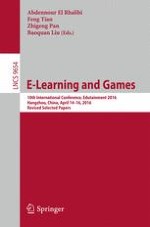2016 | OriginalPaper | Buchkapitel
ARDock: A Web-AR Based Real-Time Tangible Edugame for Molecular Docking
verfasst von : Gaoqi He, Fei Sun, Dong Hu, Xingjian Lu, Yi Guo, Shuhua Lai, Zhigeng Pan
Erschienen in: E-Learning and Games
Aktivieren Sie unsere intelligente Suche, um passende Fachinhalte oder Patente zu finden.
Wählen Sie Textabschnitte aus um mit Künstlicher Intelligenz passenden Patente zu finden. powered by
Markieren Sie Textabschnitte, um KI-gestützt weitere passende Inhalte zu finden. powered by
